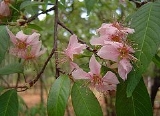
Prunus cerasoides
Encyclopedia
Prunus cerasoides is a deciduous cherry tree
found in East Asia
. It is of the family Rosaceae
and the genus Prunus
. Its range extends in the Himalayas
from Himachal Pradesh in India
to southwest China
and Burma. It grows in the forests from 1200 to 2400 metres above sea level.
and are pinkish white in color. It has smooth bark, ovoid yellow fruit that turns red as it ripens. When the tree is not in flower, it is characterised by glossy, ringed bark and long, dentate stipules.
in the soil, but is likely to become chlorotic if too much lime is present. It requires an open, sunny and sheltered location. Cerasoides, like most members of this genus, is shallow rooted and is likely to produce suckers if the root is damaged. It is known to be susceptible to honey fungus
.
The seed requires two to three months cold stratification
and is best sown in a cold frame
as early in winter as possible. The seed grows rather slowly and can sometimes take about 18 months to germinate depending on the conditions.
Cherry Tree
Cherry Tree may refer to:* A tree that produces cherries* An ornamental cherry tree that produces cherry blossomsPlaces* Cherry Tree, Pennsylvania, a borough in Indiana County, Pennsylvania, United States* Cherry Tree, Oklahoma...
found in East Asia
East Asia
East Asia or Eastern Asia is a subregion of Asia that can be defined in either geographical or cultural terms...
. It is of the family Rosaceae
Rosaceae
Rosaceae are a medium-sized family of flowering plants, including about 2830 species in 95 genera. The name is derived from the type genus Rosa. Among the largest genera are Alchemilla , Sorbus , Crataegus , Cotoneaster , and Rubus...
and the genus Prunus
Prunus
Prunus is a genus of trees and shrubs, which includes the plums, cherries, peaches, apricots and almonds. There are around 430 species spread throughout the northern temperate regions of the globe. Many members of the genus are widely cultivated for fruit and ornament.-Botany:Members of the genus...
. Its range extends in the Himalayas
Himalayas
The Himalaya Range or Himalaya Mountains Sanskrit: Devanagari: हिमालय, literally "abode of snow"), usually called the Himalayas or Himalaya for short, is a mountain range in Asia, separating the Indian subcontinent from the Tibetan Plateau...
from Himachal Pradesh in India
India
India , officially the Republic of India , is a country in South Asia. It is the seventh-largest country by geographical area, the second-most populous country with over 1.2 billion people, and the most populous democracy in the world...
to southwest China
China
Chinese civilization may refer to:* China for more general discussion of the country.* Chinese culture* Greater China, the transnational community of ethnic Chinese.* History of China* Sinosphere, the area historically affected by Chinese culture...
and Burma. It grows in the forests from 1200 to 2400 metres above sea level.
Description
P. cerasoides is a medium sized tree which grows up to 30 metres in height. It flowers in autumn and winter, specifically in January and February. Flowers are hermaphroditicHermaphrodite
In biology, a hermaphrodite is an organism that has reproductive organs normally associated with both male and female sexes.Many taxonomic groups of animals do not have separate sexes. In these groups, hermaphroditism is a normal condition, enabling a form of sexual reproduction in which both...
and are pinkish white in color. It has smooth bark, ovoid yellow fruit that turns red as it ripens. When the tree is not in flower, it is characterised by glossy, ringed bark and long, dentate stipules.
Cultivation and propagation
The tree thrives in well-drained and moisture-retentive loamy soil. It will grow well with a bit of limeLime (mineral)
Lime is a general term for calcium-containing inorganic materials, in which carbonates, oxides and hydroxides predominate. Strictly speaking, lime is calcium oxide or calcium hydroxide. It is also the name for a single mineral of the CaO composition, occurring very rarely...
in the soil, but is likely to become chlorotic if too much lime is present. It requires an open, sunny and sheltered location. Cerasoides, like most members of this genus, is shallow rooted and is likely to produce suckers if the root is damaged. It is known to be susceptible to honey fungus
Honey fungus
Honey fungus, or Armillaria or оpenky , is a genus of parasitic fungi that live on trees and woody shrubs. It includes about 10 species formerly lumped together as A. mellea. Armillarias are long lived and form some of the largest living organisms in the world...
.
The seed requires two to three months cold stratification
Stratification (botany)
In horticulture, stratification is the process of pretreating seeds to simulate natural winter conditions that a seed must endure before germination. Many seed species undergo an embryonic dormancy phase, and generally will not sprout until this dormancy is broken...
and is best sown in a cold frame
Cold frame
In agriculture and gardening, a cold frame is a transparent-roofed enclosure, built low to the ground, used to protect plants from cold weather. The transparent top admits sunlight and prevents heat escape via convection that would otherwise occur, particularly at night...
as early in winter as possible. The seed grows rather slowly and can sometimes take about 18 months to germinate depending on the conditions.
Edible uses
- Fruit — 15mm in diameter, the fruit can be eaten raw or cooked.
- Gum — Gum is chewed and obtained from the trunk. It can be employed as a substitute for gum tragacanthTragacanthTragacanth is a natural gum obtained from the dried sap of several species of Middle Eastern legumes of the genus Astragalus, including A. adscendens, A. gummifer, A. brachycalyx, and A. tragacanthus. Some of these species are known collectively under the common names "goat's thorn" and "locoweed"...
. - Seed — It can be eaten raw or cooked.

